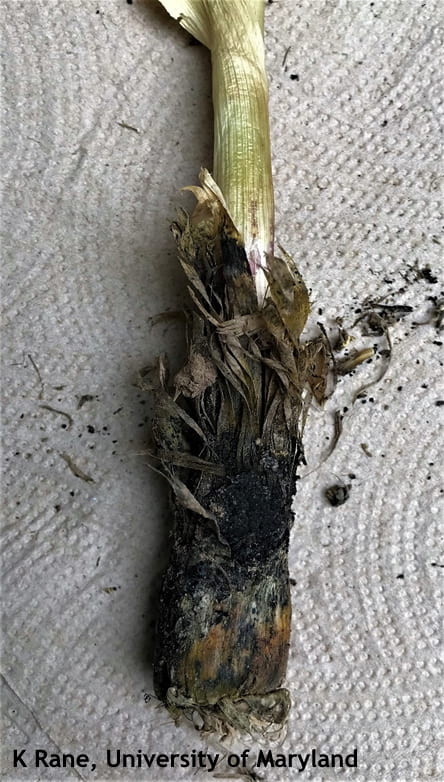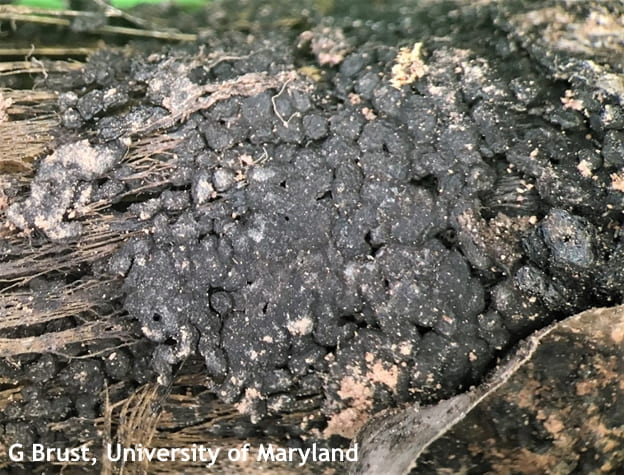Jerry Brust, IPM Vegetable Specialist, University of Maryland; jbrust@umd.edu and Karen Rane, Plant Diagnostician, University of Maryland rane@umd.edu
The weather we have had for the last month and a half has been great for seed maggots and for some soil diseases. One very serious soil disease that affects Allium species, especially onion and garlic, is white rot, caused by the fungus Stromatinia cepivorum (syn. Sclerotium cepivorum (Fig. 1)), which was found just this past week in Maryland. White rot is NOT the same as white mold, which is caused by Sclerotinia sclerotiorum, which has a very large host range (tomatoes, peppers and 170 other plant species); white rot only infects Allium species.
Leaves of Allium plants with white rot exhibit yellowing, dieback, and wilting. Under ideal weather conditions, white mycelial growth can develop on the bulb. As the disease progresses, the mycelium becomes more compacted with numerous small, spherical black bodies (sclerotia) forming on this white mat (Fig. 2). These sclerotia are the overwintering structures of the pathogen and are approximately the size of a pin head. As the disease progresses, these sclerotia are eventually released into the soil. Infected plant roots will rot, making the plant easily pulled from the soil. Disease development is favored by cool, moist soil conditions (just what we have had for many weeks this season). The soil temperature range for infection is 50°-75°F, with an optimum of 60°-65°F. At soil temperatures above 78°F, the disease is greatly inhibited. Soil moisture conditions that are favorable for onion and garlic growth are also best for white rot development.
An increase of white rot in a field that has had several Allium crops may go unnoticed for a time as sclerotia numbers increase and disperse. One sclerotium per 20 pounds of soil will cause disease and results in measurable crop loss. The sclerotia will lay dormant until root exudates, exclusively from an Allium species, stimulate germination. Root exudates from non-Allium species will not stimulate the germination of white rot sclerotia. Cool weather is needed for both sclerotia germination and mycelia growth. Mycelia will grow through the soil until they encounter an Allium root at which time the fungus initiates infection. Mycelia can grow from one plant to a nearby plant, allowing the pathogen to move between plants.
Figure 1. White rot on garlic plant
Management of white rot should focus on disease avoidance by not introducing the pathogen into a field. Sclerotia can spread throughout a field, or from field to field, through the movement of soil, equipment, or plant material (especially garlic cloves). Sanitation is important to prevent sclerotia from moving from an infested field to a clean field. Plant only clean stock from known origins that has no history of white rot. Always clean soil off of equipment and sanitize with quaternary ammonia before moving to another field. The Allium crops from an infested field should not be used as seed. Rotation alone will not control white rot because sclerotia can survive in the soil for 20-40 years. If the disease is found, reducing or eliminating irrigation will reduce the damage to the current crop but will not stop the spread of the disease.
Figure 2. Sclerotia of white rot fungus on garlic
Because the fungus is vulnerable to temperatures above 115°F, dipping seed garlic in hot water is a possible preventive measure that will reduce the amount of pathogen but will not completely eliminate it. Temperature control is important when using this method because temperatures above 120°F may kill the garlic. There are other cultural and organic practices that a grower might try to fight this disease and these can be found at: https://rvpadmin.cce.cornell.edu/uploads/doc_479.pdf
Chemical applications can be made for white rot management and include for onion tebuconazole applied in a 4-6 inch band over or into the furrow at planting or via chemigation. For garlic an in-furrow at-planting application using iprodione or tebuconazole or fludioxonil can reduce disease incidence, however there are crop rotation restrictions with the use of these chemicals so be sure to check the Mid-Atlantic Commercial Production Recommendations guide for more details.


